Neoregelia spectabilis
Click thumbnails for full size, scaled to a new window.
Neoregelia spectabilis
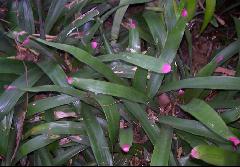
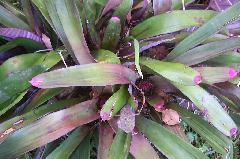
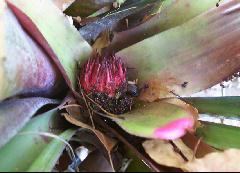
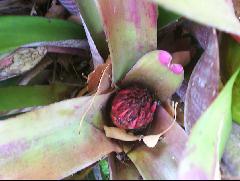
| Ian Hook, Sydney 07/02. |
Ian Hook, Sydney 12/02. |
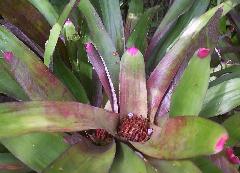
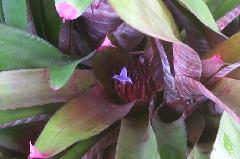

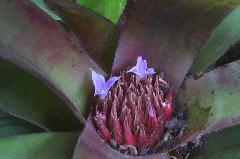
From Derek Butcher, Feb. 2012.
"This was first described as Nidularium spectabile by T. Moore in 1873.
The painting shows whitish petals but it is said these are violet-blue.
We can trace this species in Australia to the 1960’s when species were abundant and hybrids rare.
In all probability it came to Australia direct from Brazil although it could also have got here from the USA at later dates.
Some have more distinct barring on the underneath surface of the leaves and these are to be cherished."
Curtis Bot Mag 99.1873
Tab. 6024.
NIDULARIUM SPECTABILE
Native of Brazil.
Nat Ord. Bromeliacea – Tribe Ananassea
Genus NIDULARIUM, Lamaire Jardin Fleuriste, vol. Iv., Misc., p. 60, t. 441.
NIDULARIUM spectabile; acaule, caespitosum, foliis rosulatis recurvis e basi late dilatata late loriformibus (ad 2-poll. Latis) planiusculis minute distanter spinulosa-dentatis apice late sanguine rotundatis ungue rigido terminates supra viridibus subtus glaucaescentibus albo transverse fasciitis, floribus in fasciculum multiflorum terminalem sessile dense congestis, bracteis lanceolatis acuminates purpureis calycem aequantibus calycis lobis oblongis longe cuspidatis sanguineis, petalis infra medium in tubum connatis dein ellipticis acuminates recurvis violaceis, antheris sessilibus.
NIDULARIUM spectabile, T.Moore in Gard. Chron., 1873, p.8.
The genus Nidularium was established by Lemaire in 1854, and includes various species of the old genera Bromelia, Billbergia, &c., together with others, of which a dozen are enumerated by Morren, in his valuable “Catalogue des Broméliacees cultivées au Jardin Botanique de l’Université de Liege” (1873.) Among them N. Meyendorffii, Regal, (Billbergia olens, Tab. Nost. 5502), is the only one quoted as being hitherto figured in the “Botanical Magazine.” The genus is probably a large one, and we have dried specimens of the foliage of several Brazilian species, beside the considerable number that are in cultivation.
N. spectabile was imported by Mr. Bull from the interior of Brazil, and flowered in his establishment in December, 1872. It is a very striking plant, allied to N. Meyendorffii, Lemaire (Ill. Hort, t, 245), but very distinct; and may at once be recognised from any species hitherto cultivated in England, by the singular bright blood-red ends of the leaves, which form a clearly defined and singular contrast both to the bright green of the upper surface and the glaucous dull green of the lower surface of the leaf.
Descr. Tufted, stemless. Leaves twelve to fourteen inches long by one and a half to two inches broad, inner shorter, broadly strap-shaped from a very broad sheathing base, slightly concave, points rounded with a beak-like cusp, margin with small remote spiny teeth, upper surface dark green except the tip, which presents a bright blood-red patch half an inch deep on both surfaces; under surface covered with alternate dull green and dirty white lepidote transverse bands; towards the base of the leaf the green bands are purplish. Flowers numerous in a crowded terminal flat-topped fascicle, one and three quarters to two inches in diameter, sunk amongst the uppermost leaves, spinulose from the prominent bracts, which are lanceolate concave, rose-purple above the middle, and terminate in acircular points. Ovary ovoid, white. Calyx-limb of three elliptic blood-red segments, terminating in erect acircular points, which equal the corolla-tube. Corolla-tube pale, obtusely 3-angled; limb three quarters of an inch diameter, of three spreading and recurved ovate acuminate violet-blue segments. Anthers linear-oblong, sessile in the mouth of the tube. – J.D.H.
Fig.1, Whole plant reduced; 2, flower and bracts; 3, portion of tube and a segment of corolla with anthers; 4, ovary: - all magnified.
MARCH 1st, 1873.
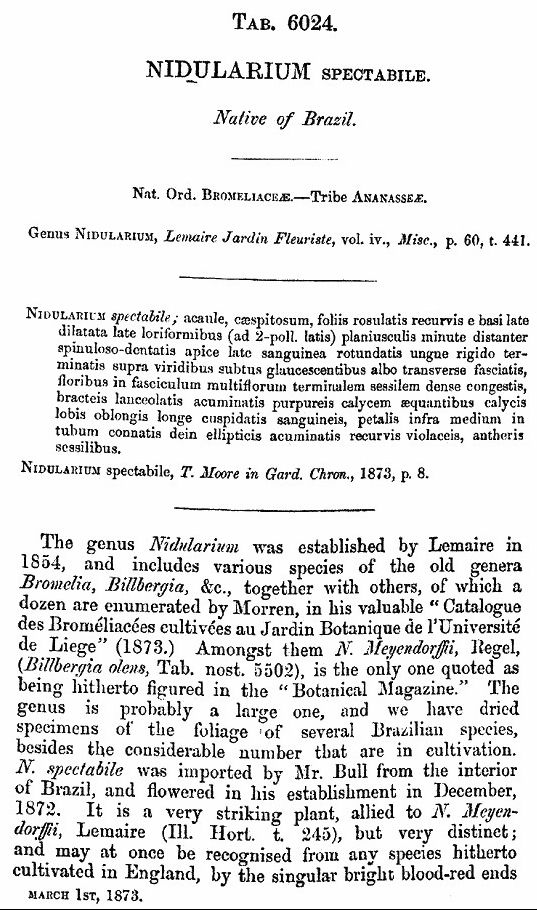

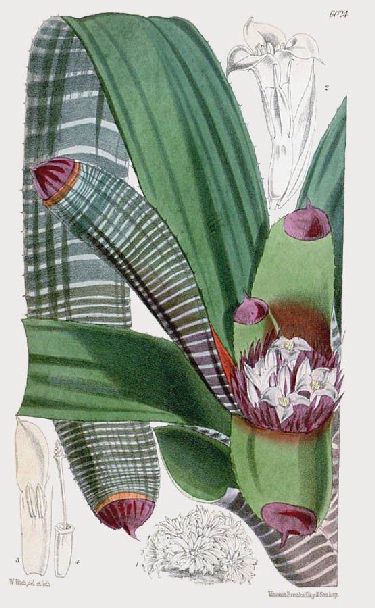
| Original article and Fig.1, thanks to Derek Butcher. |
Neoregelia spectabilis Variegated
or "Foster's variegated spectabilis"
or N. Jaffa (proposed name)
- See listing under N. Jaffa this website, "Cultivars".
Updated 06/02/17













